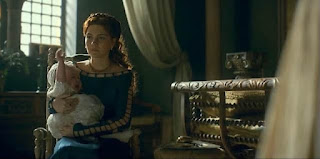Game of Thrones: House of the Dragon and Mothering
Lately, my little guy has refused to nap unless he's "contact napping" (an official-sounding parenting term that essentially means "lying entirely on top of Mommy"). So, to make sure he gets in anything even resembling a nap, I play the role of mattress for a couple hours a day. Because of this, I've been able to catch up on some recently airing shows. And I can now tell you that it's rather surreal watching the ruthlessness of House of the Dragon while cuddling a sleeping baby. But what's even stranger is that this show has turned out to be all about mothers.
For better and for worse.
This Game of Thrones prequel focuses on the power struggles within the Targaryen family and house, specifically on the potential inheritance of the Iron Throne. Pretty standard for Game of Thrones. But what strikes me about this series is how female-focused it is, as the main conflicts that drive the show are between two women, both of whom are mothers (at least they both are by midway through the season).
"From [its] first episode, 'Dragon' slid into the bad habits of its predecessor, swapping a predilection for sexual violence and rape with one for traumatic births. In the first six episodes, three gratuitous birth scenes included two that ended in the death of both mother and baby. It's clear from the way these scenes were filmed, and what the creators have said about them, that their intentions were good. But the scenes came off not as revolutionary or revelatory, but [instead as] exploitative... The spectacle of the violence was the focal point. So was the pain and trauma of the woman, not realism or the experience of the mother."
 |
| A moment from the forced C-section scene, House of the Dragon Episode 1 |
I'm rather on the fence on the depictions of birth in the series, personally. Like many women, I would have liked HBO to have given a content warning before the episodes with graphic birth scenes. Like sexual violence, birth can be a traumatic experience for many women and other birthing peoples, and thus seeing such violent and death-centric scenes can be as triggering as the former Game of Thrones' scenes of sexual violence. I actually did find myself having to fast forward through the premiere's forced C-section scene, even though I had been given prior warning about the scene from a parenting forum. Also, as I've discussed before, having the only depictions of C-sections being ones that end in death is a broader societal problem, one that can't be addressed especially well in the dark and semi-medieval-set Game of Thrones.
**Note: the actor who plays Princess Rhaenyra at this point in the series is non-binary; however, as the character in the show continues to be portrayed as female, I'm continuing to use she/her pronouns when discussing the character in this blog post.
What really makes me pause, though, is which aspects of motherhood are highlighted in this show and which are not. What I noticed most of all is that House of the Dragon features the parts of motherhood that are connected to fierceness and violence, but the tenderness and nurturing of motherhood is almost entirely absent. Crying babies are often shuttled off to nurses, and the older children are brought up surrounded by violence, some threatening them and some protecting them.
Queen Alicent and Princess Rhaenyra both fiercely worry about the lives of their children if the other line ascends to the Iron Throne, and thus the children are always both protected and in danger. Alicent screams at one of her children about the danger to his life, but also strikes him over his own violence and cruelty to others. When another one of her children loses an eye, the Queen furiously demands vengeance: a literal eye for an eye. Rhaenyra is equally capable of violence, not batting an eye as those who would question her and her children's right to the throne are (literally) cut down in front of her. The gentle kindness of Rhaenyra's children imply that they have been brought up with tenderness, but the time-skips mean that the audience is never shown that side of Rhaenyra; one can only guess at what kind of mother she was in the children's earlier years.
The interesting thing is that, for all its dismissal of and outright cruelty towards its female characters, the original Game of Thrones actually had no shortage of motherly tenderness and strength in the act of caretaking. Catherine Stark is shown being a calm and nurturing mentor to her children, both their in youths and adulthood. She expresses to many characters how much she loves and cares for her children, and she says not long before her death that her deep regret is essentially that she didn't love even more by extending that motherly affection to "a motherless son," Jon Snow. The character Gilly is also a strong and nurturing mother, protecting her baby Sam and caring for him in a sweet, nurturing way even in extreme conditions. (And she ends up being the one who solves the core secret of the Targaryen line at the same time. Gilly isn't the flashiest character in the original show, but she is quietly amazing.)
Even the often shockingly cruel Queen Cersei is shown in all her complexity as occasionally a soft, nurturing, and loving mother. Besides her grief over her children's deaths throughout the series, moments which are truly heartbreaking, she also has one notable scene when she reflects on the tenderness of holding her eldest son when he was a newborn:
"I used to spend hours looking at him.
His wisps of hair.
His tiny little hands and feet."
Even the religion in the series took the time to highlight this aspect of motherhood, this nurturing tenderness. The Faith of the Seven often honors the Mother, which the guide says stands for "the strength of women," which includes nurturing, mercy and peace.
While House of the Dragon centers women and mothers more than the original Game of Thrones, I find myself missing those moments of motherly tenderness. Princess Rhaenyra Targaryen and Queen Alicent are both fierce dragons, cutting down their enemies and protecting their children with viciousness. In this new series, the violence of motherhood, in both the act of birth and in a mother's protectiveness of her children, is shown, but none of the softness, affection, or care.
It's strange to actually miss something about the depictions of women in the original Game of Thrones, but I find myself agreeing with Kelly Lawler when she explains:
"When series are realistic about birth and infant care and motherhood, it can be a radical act. When I think of pop culture that can capture what it's really like to birth and care for a newborn, the list is desperately short... [but House of the Dragon] hit[s] the wrong note."
That said, I plan on watching the rest of the season, either with a Negroni Sbaglito or (more likely) while pinned under a sleeping baby. If the latter, I expect I'll take a few extra quiet moments to give my little one some extra, soft snuggles when the episode is over.







Comments
Post a Comment